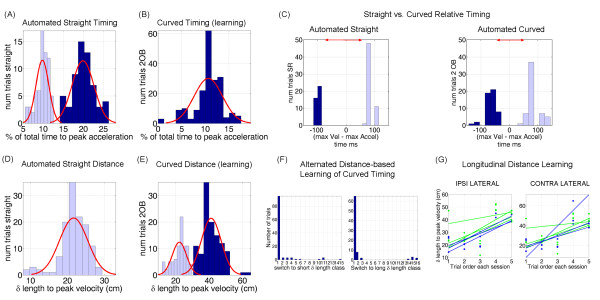Figure 7.
Hand trajectories: Straight vs. curved timing and distance. (A) Automated straight timing had two trial-clusters according to the percentage of total movement time to attain the maximum magnitude of the acceleration vector. In one trial-class the hand accelerated maximally much earlier than in the other. Across spatial targets trials lasted 500-700 ms. (B) Learning the curved timing turned this distribution unimodal. (C) Automated straight timing showed two clusters of trials according to the relative time difference between velocity and acceleration maxima. Negative values indicate that the maximum magnitude of the acceleration was reached before the maximum speed. Automated curved timing trials lasted 700-850 ms, spread out the clusters and shifted (contracted) the time-length relative difference between speed and acceleration maxima. (D) Straight path had a unimodal uniform distribution of distance (delta) travelled to the peak velocity. (E) Curved-distance learning turned this distribution non-unimodal. (F) Alternating adjustment strategy of delta in curved-timing learning. If in trial n the hand would travel a short delta, most probably in trial n+1 the hand would travel a long delta. (D) When grouping consecutive trials in one day a monotonic trial-by-trial trend was revealed with an increase of the delta adjusted from one trial to the next. This trend was also observed across consecutive days of training during a week. Blue are from the (multi-peaked speed) learning phase and green are from the (single-peaked speed) automated motions.

